

Impress Guide 24.2
Chapter 1 Introducing Impress
Presentations in LibreOffice
This document is Copyright © 2024 by the LibreOffice Documentation Team. Contributors are listed below. This document maybe distributed and/or modified under the terms of either the GNU General Public License (https://www.gnu.org/licenses/gpl.html), version 3 or later, or the Creative Commons Attribution License (https://creativecommons.org/licenses/by/4.0/), version 4.0 or later. All trademarks within this guide belong to their legitimate owners.
Contributors for this edition:
Peter Schofield
Contributors for previous editions:
Claire Wood
Dimona Delvere
Gary Schnabl
Hazel Russman
Jean Hollis Weber
Kees Kriek
Linda Worthington
Michele Zarri
Peter Hillier-Brook
Peter Schofield
Rachel Kartch
T. Elliot Turner
Vasudev Narayanan
Please direct any comments or suggestions about this document to the Documentation Team Forum at https://community.documentfoundation.org/c/documentation/loguides/ (registration is required) or send an email to: loguides@community.documentfoundation.org.
Note
Everything sent to a mailing list, including email addresses and any other personal information in the message, is publicly archived and cannot be deleted.
Published May 2024. Based on LibreOffice 24.2 Community.Other versions of LibreOffice may differ in appearance and functionality.
Some keystrokes and menu items are different on macOS from those used in Windows and Linux. The table below gives some common substitutions used in this document. For a detailed list, see LibreOffice Help.
|
Windows or Linux |
macOS equivalent |
Effect |
|
Tools > Options |
LibreOffice > Preferences |
Access setup options |
|
Right-click |
Control+click, Ctrl+click, or right click depending on computer setup |
Open a context menu |
|
Ctrl or Control |
⌘ and/or Cmd or Command, depending on keyboard |
|
|
Alt |
⌥ and/or Alt or Option depending on keyboard |
Used with other keys |
|
F11 |
⌘+T |
Open the Styles deck in the Sidebar |
Impress is the presentation (slide show) module included in LibreOffice for creating presentations using the Open Document Presentation (ODP) format. Using Impress allows the creation of presentations that can include charts, drawing objects, text, multimedia and a variety of other items. Presentations created in ODP format can be opened by other presentation software (for example Microsoft PowerPoint), or exported in different presentation formats (for example PPT).
Slides created for presentations can contain many different elements, including animation, slide transitions and multimedia are a few of the techniques available in Impress. Using these techniques can make a presentation look more professional and interesting for an audience.
Several views are available when designing and creating a presentation. For example, the Slide Sorter displays an overview of slides in thumbnail form, while the Handout page contains both the slide and the notes for distribution to audiences. Also Impress has a Presenter Console that is used when rehearsing a presentation and to show the presentation to an audience.
Using graphics in a presentation does require some knowledge of drawing and it is recommended to refer to the LibreOffice Draw Guide for more information on how to create graphics, including 3D animation.
Notes
When LibreOffice is installed on a computer, a menu entry for each module is added to the system menu. The exact name and location of these menu entries depends on the operating system and graphical user interface being used.
The New icon displayed on the Standard toolbar depends on which LibreOffice module is open when creating a new document, presentation, spreadsheet, or drawing.
By default, when no other LibreOffice module is open, the LibreOffice Start Center opens giving the following options:
Click on Impress Presentation to create a new presentation.
Click on Open File and navigate to the folder that contains an existing presentation.
Click on Remote Files and navigate to the remote server and folder that contains an existing presentation.
Using the system menu where most applications are started. The details vary depending on the operating system being used. See the Getting Started Guide for more information and some examples are listed below:
Start menu in Windows.
Applications menu in Linux with a Gnome desktop.
Applications menu in macOS.
Using the one of the following options when a LibreOffice module is open:
Go to File > New > Presentation on the Menu bar.
Click on the triangle ▼ next to New on the Standard toolbar and select Presentation from the drop-down menu.
Figure 1: Main Impress window

(1) Slides pane
(2) Workspace
(3) Sidebar
Figure 2: Select a Template dialog
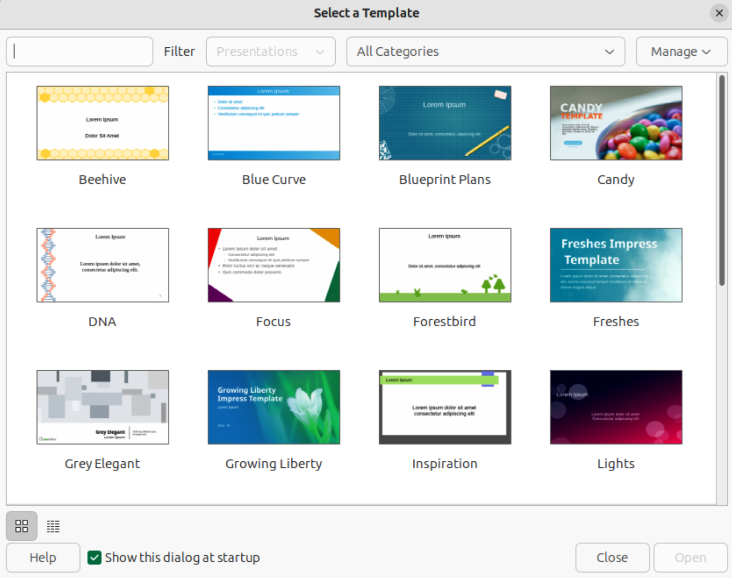
When starting Impress, the main Impress window (Figure 1) opens and, by default, the Select a Template dialog (Figure 2) also opens. Templates included with Impress are designed to fit the two standard sizes of presentation slides: 4:3 and 16:9 ratios. However, templates will adapt to other sizes that are available and can be selected by going to Slide > Slide Properties > Paper Format on the Menu bar, or Format in the Slide panel in the Properties deck on the Sidebar.
Tips
To start Impress without the Select a Template dialog opening, deselect the option Show this dialog at startup in the lower left of the dialog. Alternatively, go to Tools > Options > LibreOffice Impress > General (macOS LibreOffice > Preferences > LibreOffice Impress > General)on the Menu bar and deselect Start with Template Selection in New Document.
The Slides pane and/or Sidebar can be closed by clicking the X in the upper right corner of each pane, or go to View > Slide Pane or View > Sidebar on the Menu bar to deselect. To reopen a pane, select View > Slide Pane or View > Sidebar on the Menu bar.
To maximize the Workspace area click on the Hide/Show marker in the middle of the vertical separator line (highlighted in Figure 1). Using the Hide/Show marker hides the Slides pane or Sidebar, but does not close them. To restore the Slides pane or Sidebar, click again on its Hide/Show marker.
The main Impress window (Figure 1) has three main sections: Slides pane, Workspace, and Sidebar. At the top of the main window is the Menu bar and toolbars. Toolbars can be displayed or hidden during the creation of a presentation.
The Menu bar, at the top of the main window, provides several menus common to all LibreOffice modules. The commands may differ between each LibreOffice module for File, Edit, View, Insert, Format, Tools, Window, and Help. Impress has two extra menus for Slide and Slide Show. When a menu is selected, a submenu opens to show the available commands. The Menu bar can be customized and for more information, see the Getting Started Guide.
By default, the Workspace opens in Normal view which is normally positioned at the top of the main window. The Workspace has four standard views: Normal; Outline; Notes; Slide Sorter. Each view is opened by clicking on the tab at the top of the Workspace (Figure 3). For more information on workspace views, see “Workspace views” on page 1.
If master slides are being used, then master views become available: Master Slide; Master Notes; Master Handout. There are no tabs for master views and these are selected by going to View on the Menu bar. For more information on master slides, see Chapter 2, Using Slide Masters, Styles, and Templates.
Figure 3: Workspace view tabs

The Slides pane displays thumbnail images of slides in the same order used when the slides are displayed in a presentation. Clicking on a slide image in the Slides pane selects it and places the slide in the Workspace where changes are made to the displayed slide. The order of the slides in a presentation can be changed, see Chapter 9, Slide Shows & Photo Albums for more information.
To display or close the Slides pane, go to View > Slide Pane on the Menu bar.
To close the Slides pane, click on the X in the right top corner of the Slides pane.
To display or hide the Slides pane, use the Hide/Show marker on the left of the Workspace (indicated in Figure 1 on page 1).
Several additional operations can be carried out on one or more slides in the Slides pane. These additional operations are available from a context menu that is displayed when right-clicking on a slide in the Slides pane.
Add new slides to a presentation.
Duplicate a slide.
Rename a slide.
Hide a slide so that it will not show in a presentation.
Delete a slide from a presentation.
Move a slide to another position in the slide order by dragging and dropping it to the desired position.
Change the layout for a slide, or a group of slides.
Navigate to select slides in the presentation.
Move a slide to another position in the slide sequence.
Change slide properties by opening the Slide Properties dialog.
The Impress Sidebar (Figure 4) is normally located on the right side of the Workspace and is similar to the Sidebar in the other LibreOffice modules. The Impress Sidebar consists of nine decks and to display or hide the Sidebar, use one of the following methods:
Go to View > Sidebar on the Menu bar.
Use the keyboard shortcut Ctrl+F5 (macOS ⌘+F5).
Use the Hide/Show marker on the right of the Workspace (indicated in Figure 1 on page 1).
To hide the Sidebar, click on the X in the right top corner of the Sidebar.
To display the Sidebar, click on one of the Sidebar icons to open a deck.
To open an Impress Sidebar deck, use one of the following methods:
Click on the icon for the Sidebar deck displayed on the right side of the Sidebar.
Click on Sidebar Settings at the top right of the Sidebar and select a deck from the drop‑down list.
Figure 4: Impress Sidebar — Properties deck

Use one of the available keyboard shortcuts for Sidebar decks. These keyboard shortcuts are displayed when the cursor is hovered over an icon.
Note
Actual panels displayed in the Impress Sidebar depends on the type of object that is selected on a slide.
The Properties deck (Alt+1, macOS ⌥+1) has ten panels, allowing changes to slide layout and objects formatted on a slide.
When a slide is selected and appears in the Workspace, the Properties deck opens with the Slides and Layouts panels displayed.
When an object on a slide is selected, the following panels in the Properties Deck become available: Character; Paragraph; Lists; Area; Shadow; Line; Position and Size; Columns; Effect; Image. Actual panels displayed depends on the type of object selected.
In the Styles deck (Alt+2, macOS ⌥+2) is used for the following tasks:
Drawing and presentation styles are applied to a selected object.
New styles created for drawing and presentation.
Drawing and presentation styles can be modified.
When saving changes to a style, the changes are applied to all of the elements formatted with that style in the presentation. For more information on styles, see Chapter 2, Using Slide Masters, Styles, and Templates.
Using the Gallery deck (Alt+3, macOS ⌥+3), an object is inserted into a presentation either as a copy or as a link.
A copied object is independent of the original object.
Changes to the original object have no effect on the copy.
A link remains dependent on the original object.
Changes to the original object are also reflected in the linked object.
The Navigator deck (Alt+4, macOS ⌥+4) displays all objects contained in a presentation. It provides a convenient way to move between slides in a presentation, or select an object on a slide. It is recommended to give slides and objects in a presentation meaningful names for easy identification when using the Navigator. For more information, see “Navigator” on page 1.
The Shapes deck (Alt+5, macOS ⌥+5) provides panels for quick selection of basic shapes that are available on the Drawing toolbar: Lines and Arrows; Curves and Polygons; Connectors; Basic Shapes; Symbol Shapes; Block Arrows; Flowchart; Callout Shapes; Stars and Banners; 3‑D Objects.
The Slide Transition deck (Alt+6, macOS ⌥+6) provides a selection of slide transitions used in a presentation. There are controls to adjust transition speed, automatic or manual transition, and how long a selected slide is shown (automatic transition only). For more information on transitions, see Chapter 9, Slide Shows & Photo Albums.
The Animation deck (Alt+7, macOS ⌥+7) is used to add, change, or remove animations for different elements or objects on a slide and adjust how objects appear during a slide show. For more information on animation, see Chapter 9, Slide Shows & Photo Albums.
The Master Slides deck (Alt+8, macOS ⌥+8) provides access to slide designs for presentations and several designs of master slides are available. The default master slide is blank, but the remaining master slides have backgrounds and styled text. For more information on master slides, see Chapter 2, Using Slide Masters, Styles, and Templates.
Rulers are positioned on the upper and left-hand sides of the Workspace. If the rulers are not visible, go to View > Rulers in the Menu bar. Rulers show the size of a selected object on the slide using double lines (highlighted in Figure 5). Rulers are also used to manage object handles and guide lines when positioning objects.
To change the measurement units, right-click on a ruler and select the measurement unit from the drop-down list, as shown in Figure 6 for the horizontal ruler. The horizontal and vertical rulers can be set to different measurement units.
Figure 5: Object size indicators on rulers
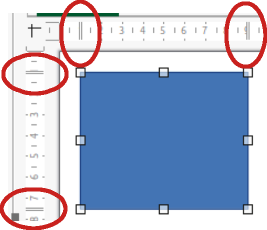
Figure 6: Changing ruler measurement units
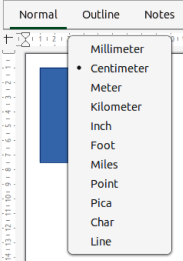
The page margins in the drawing area are also represented on the rulers. The margins are changed directly on the rulers by dragging them with the cursor. The margin area is indicated on the rulers or borders around the unused area of the ruler. This margin indication depends on computer setup and operating system, but is normally in the top left corner of the Workspace.
Note
The sizes are given in the current measurement unit and might not be the same as the ruler units. The measurement unit on the Status bar is defined in Tools > Options > LibreOffice Impress > General (macOS LibreOffice > Preferences > LibreOffice Impress > General).
The Status Bar (Figure 7), located at the bottom of the Impress main window containing information for working with the presentation that is open. To hide the Status Bar, go to View on the Menu bar and deselect Status Bar.
Slide number
Figure 7: Status Bar

(1) Slide number
(2) Information area
(3) Master slide
(4) Cursor position
(5) Object size
(6) Unsaved changes
(7) Digital signature
(8) Text language
(9) Fit slide
(10) Zoom slider
(11) Zoom percentage
Information area
Table 1: Example of information on Status Bar
|
Example selection |
Examples of information shown |
|
Text area |
Text Edit: Paragraph x, Row y, Column z |
|
Charts, spreadsheets |
Embedded object (OLE) “ObjectName” selected |
|
Graphics |
Bitmap with transparency selected |
Master slide
Cursor position/Object size
– When no object is selected, the position numbers show the current position (X and Y coordinates) of the cursor.
– When an object is selected and resized using the cursor, the object size numbers show the size of the object (width and height).
– If an object is selected, the position numbers show X and Y coordinates of the object upper‑left corner and the object size number pair displays the size of the object. These numbers do not relate to the object itself, but to the selection outline, which is the smallest possible rectangle that can contain the visible part or parts of an object.
Unsaved changes
Digital signatures
Text language
Fit slide
Zoom slider
Zoom percentage
The Navigator displays all objects contained in a presentation providing a convenient way of moving within a presentation and locating objects in the presentation.
To open the Navigator dialog (Figure 8) go to View > Navigator on the Menu bar (Ctrl+Shift+F5, macOS ⌘+Shift+F5).
Alternatively, click on Navigator in the Sidebar (Ctrl+Alt+4, macOS ⌘+⌥+4) to open the Navigator deck. This Sidebar deck is similar in appearance and function as the Navigator dialog.
The Navigator is more useful if slides and objects (images, spreadsheets, and so on) are given meaningful names, instead of leaving them with default names (for example “Slide 1” and “Shape 1” and so on as shown in Figure 8). Using meaningful names makes slides or objects easily identified and located in a presentation.
Figure 8: Navigator dialog
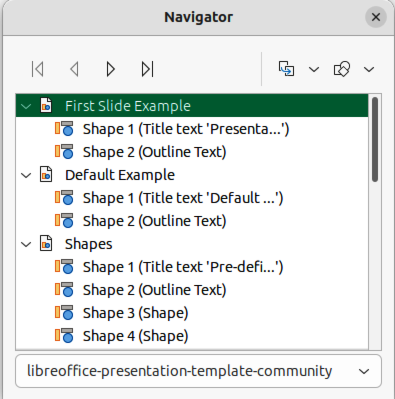
Toolbars provide several tools for creating slides for a presentation. To display or hide various toolbars in Impress, go to View > Toolbars on the Menu bar and select the required toolbar from the submenu that appears. For example, Standard and Drawing toolbars are displayed by default, but Line and Filling, and Text Formatting toolbars are not normally displayed and have to be selected.
To change tools available on any toolbar, right-click in an empty area on the toolbar and select Visible Buttons from the context menu. Installed tools are indicated by a check mark next to the tool name, or the tool icon is highlighted, depending on the computer operating system. Select a tool name to hide or show it in the toolbar. For more information, see Chapter 11, Setting Up and Customizing Impress; Appendix B, Toolbars; Getting Started Guide.
Note
The appearance of toolbar icons varies depending on the computer operating system., Select the icon size and style in Tools > Options > LibreOffice > View (macOS LibreOffice > Preferences > Options > LibreOffice > View). For more information on toolbars, see Appendix B, Toolbars and the Getting Started Guide.
The following toolbars are normally used when creating a presentation:
Standard toolbar
Figure 9: Standard toolbar

Drawing toolbar
Figure 10: Drawing toolbar

Line and Filling toolbar
Figure 11: Line and Filling toolbar

Text Formatting toolbar
Figure 12: Text Formatting toolbar

The Impress Workspace has four standard views Normal, Outline, Notes, and Slide Sorter. Each Workspace view is designed to make it easier to complete certain tasks. The different views can be selected using one of the following methods:
Click on a tab at the top of the Workspace (Figure 3 on page 1). If the tabs are not displayed, then go to View > Views Tab Bar on the Menu bar.
Go to View on the Menu bar and select a Workspace view from the options in the submenu.
The Impress Workspace has three master views available for creating master slides in a presentation. There are no tabs for master views and are opened by selecting the required option in View on the Menu bar. Options available are Master Slide, Master Notes, and Master Handout. For more information on master slides, see Chapter 2, Using Slide Masters, Styles, and Templates.
Normal view (Figure 13) is the main standard view for creating individual slides in a presentation. In Normal view slides are designed with text, graphics, and any animation effects added and formatted. Placing a slide in Normal view of the Workspace, click on the slide thumbnail in the Slides pane, or click on the slide name in the Navigator dialog or Navigator deck in the Sidebar.
Figure 13: Example of Workspace Normal view
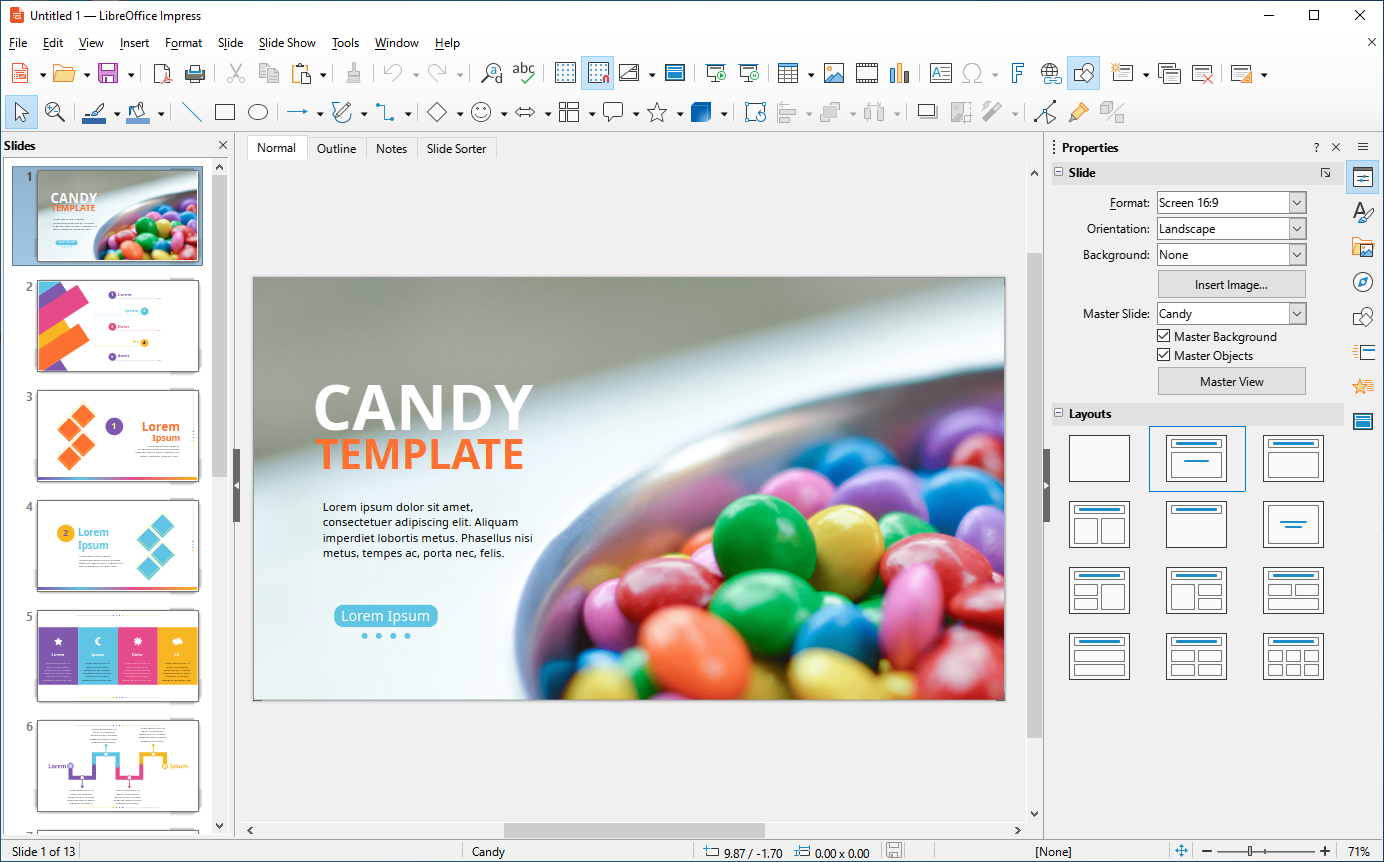
Outline view in the Workspace (Figure 14) displays all the presentation slides as a sequential list. It shows topic titles, bulleted lists, and numbered lists for each slide in outline format. Only text contained in the default text boxes in each slide is shown. If text boxes or graphic objects have been added to the slides, then these objects are not displayed. Slide names are not included.
Outline view is used for the following:
Making changes in the text of a slide.
Figure 14: Example of Workspace Outline view
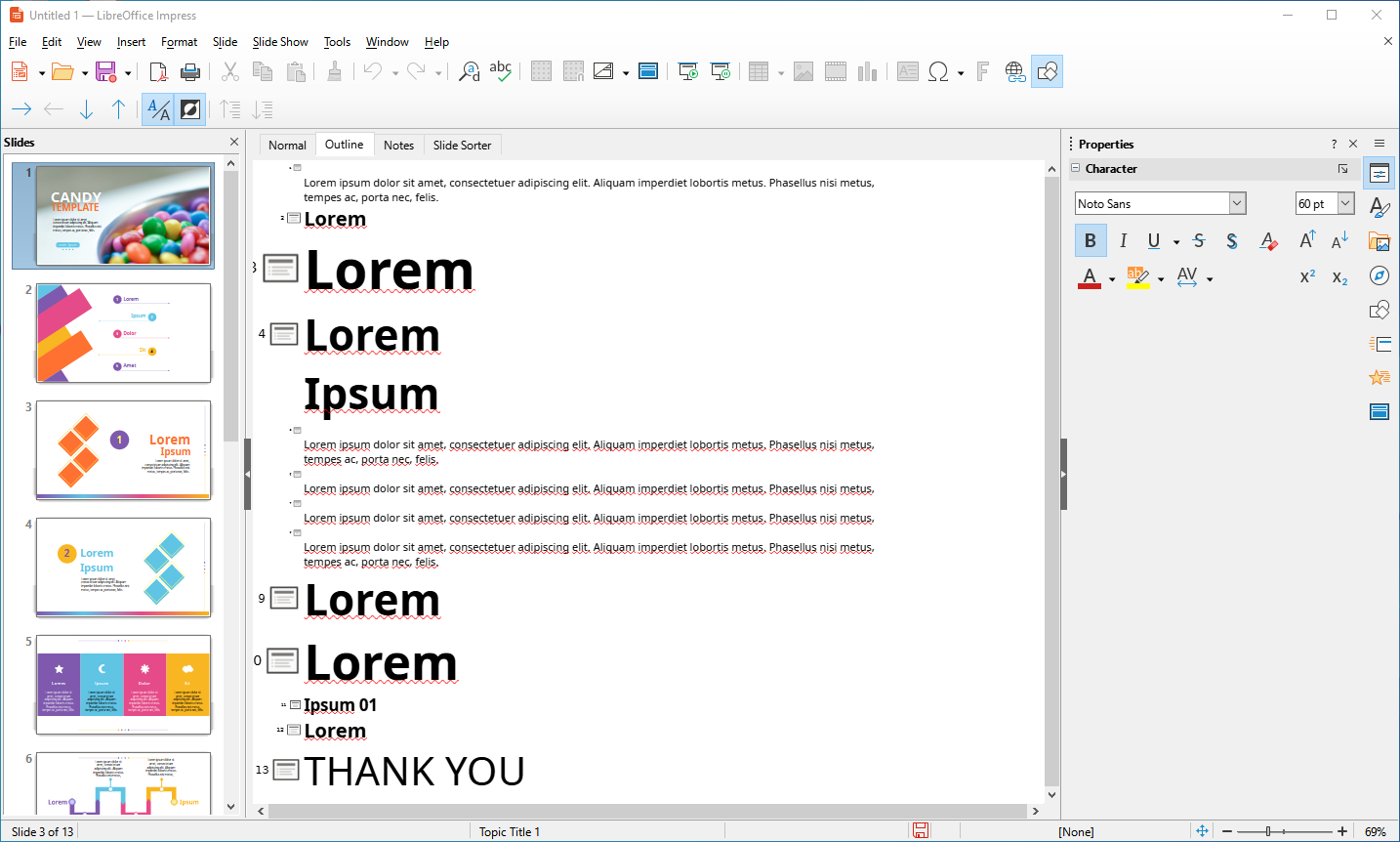
Figure 15: Outline toolbar

Adding or deleting text in a slide as in Normal view.
Moving a paragraph up or down by using the movement arrows on the Outline toolbar (Figure 15).
Changing outline level of a paragraph in a slide using the left and right arrow buttons on the Outline toolbar.
Comparing slides with an outline, if an outline has been prepared in advance. If another slide is required, it can be created directly in Outline, or Normal view.
Use Notes view in the Workspace (Figure 16) when adding notes to a slide. When a presentation is being shown, Notes are not displayed to an audience on the external display being used for the presentation.
1) Click on Notes in the Workspace to open Notes view.
2) Select a slide in the Slides pane so that the slide appears in the Workspace.
3) In the text box below the displayed slide, click on the words Click to add notes and enter the required notes for the selected slide.
The Click to add notes text box can be resized using the resizing handles which appear when the border of the box is selected. To move or change the size of the box, click on a selection handle on the box border and drag it to resize the box.
Figure 16: Example of Workspace Notes view
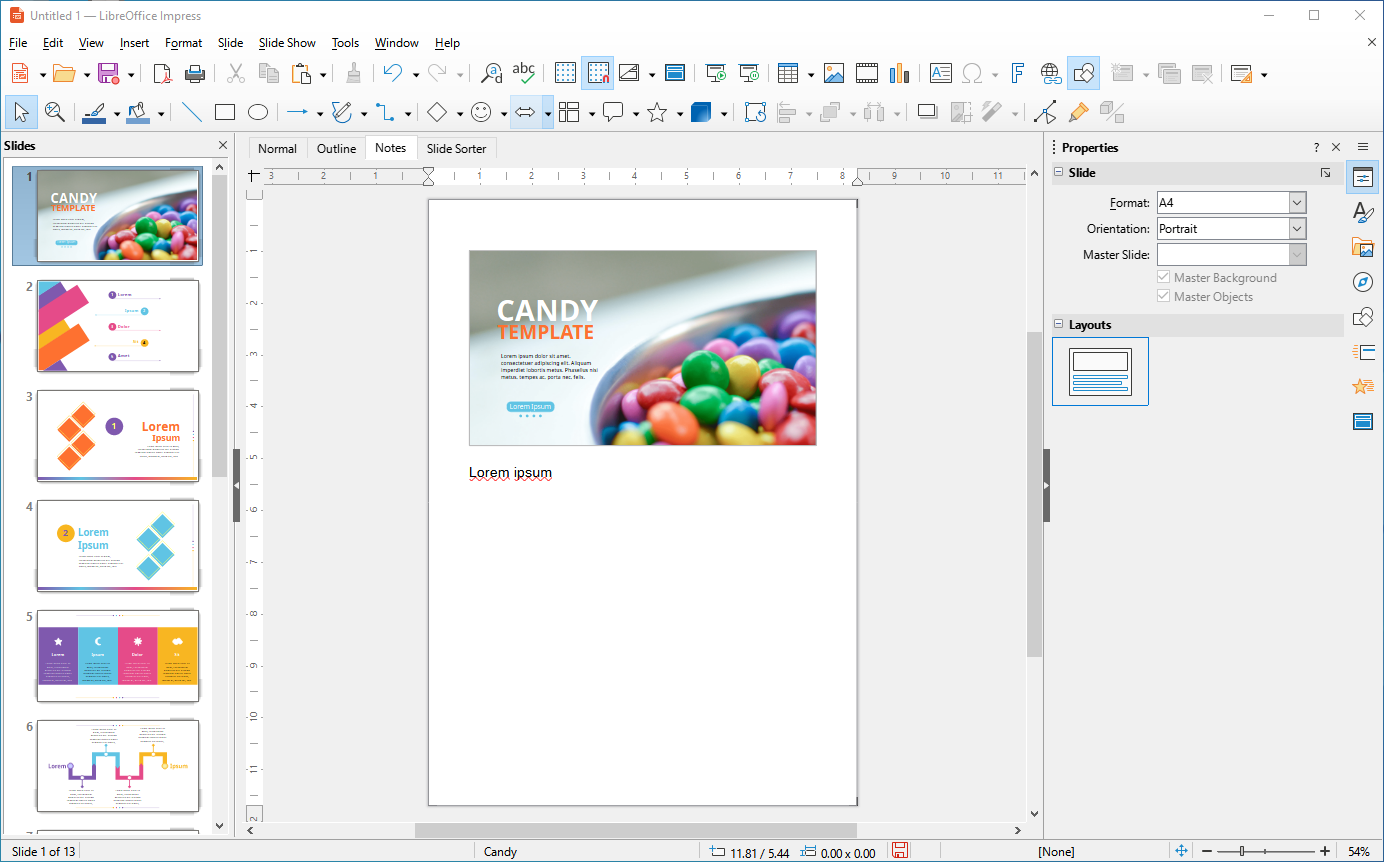
When text is inserted in the Click to add notes text box, it is automatically formatted using the predefined Notes style in Presentation Styles in the Styles deck on the Sidebar. The Notes style can be formatted to presentation requirements. For more information, see Chapter 8, Adding and Formatting Slides, and Notes.
The Slide Sorter view in the Workspace (Figure 17) contains thumbnails of each slide used in a presentation. Use Slide Sorter view to work with one slide or a group of slides.
1) Go to View > Toolbars > Slide View on the Menu bar to show the Slide View toolbar (Figure 18).
2) Adjust the number of slides in the Slides per Row box, up to a maximum of 15.
Figure 18: Slide View toolbar

Figure 17: Example of Slide Sorter view
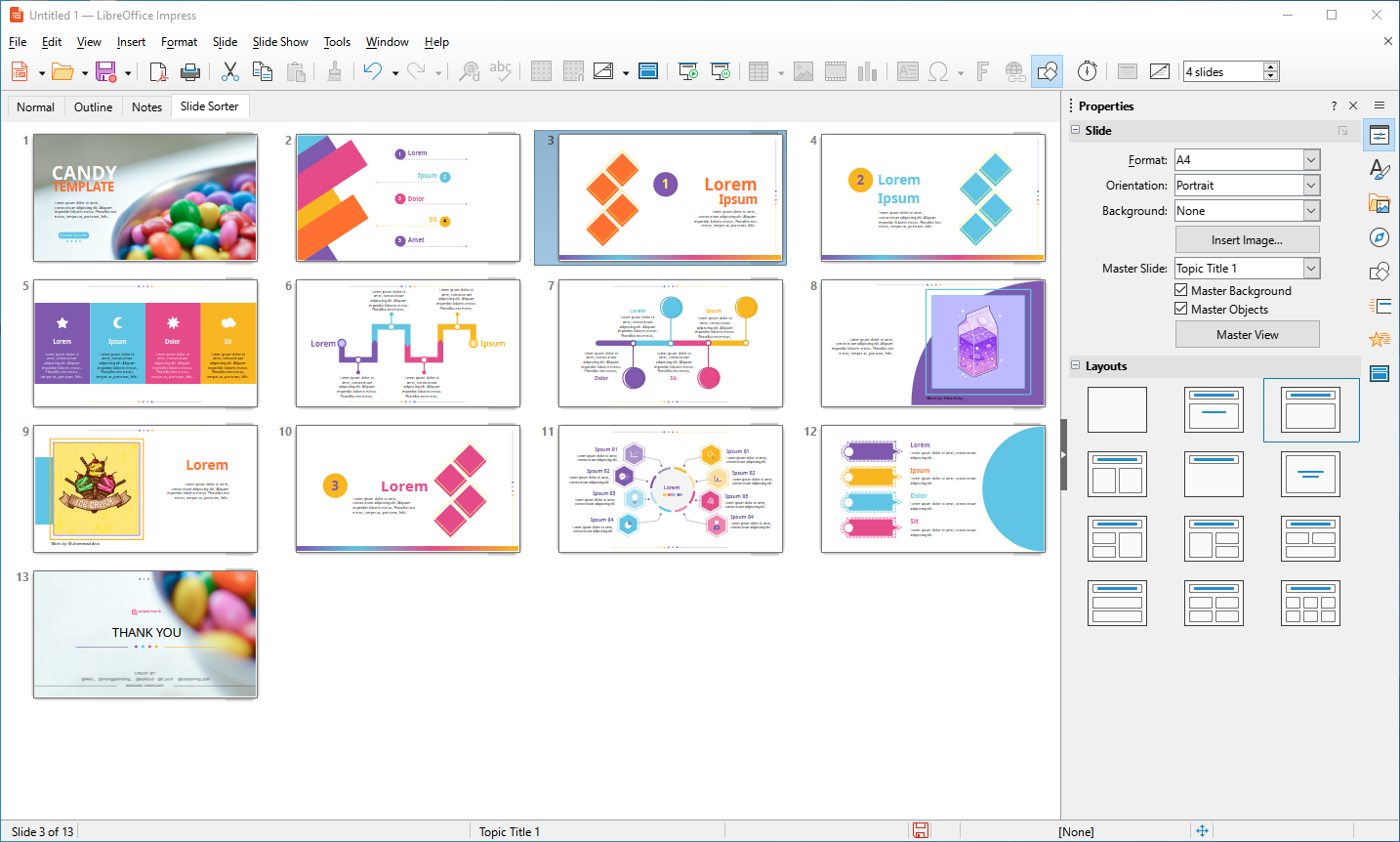
To change the slide order in a presentation of a single slide or a group of slides using Slide Sorter view is as follows:
1) Select a slide or a group of slides.
2) Drag and drop the slide or group of slides at the new position in the presentation.
To select a group of slides in Slide Sorter view, use one of the following methods:
Ctrl key (macOS ⌘) — click on the first slide and, while holding the Ctrl key, select the required slides. The selected slides do not have to be next to each other.
Shift key — click on the first slide, and while pressing the Shift key, select the final slide for the group. This selects all of the slides between the first and the last slide selected.
Click and drag — position the cursor slightly to one side and outside the first slide, then click and drag the cursor until all of the slides required for the group are selected.
Working with slides in Slide Sorter view is similar to working with slides in the Slides pane. To make changes, right-click on a slide in Slide Sorter view and choose one of the following commands from the context menu:
Table 2: Slide Sorter commands
|
Command |
Action |
|
Cut |
Removes the selected slide and saves it to the clipboard. |
|
Copy |
Copies the selected slide to the clipboard without removing it. |
|
Paste |
Inserts a slide from the clipboard after the selected slide. |
|
New Slide |
Adds a new slide after the selected slide. |
|
Duplicate Slide |
Creates a duplicate of the selected slide and places the new slide immediately after the selected slide. |
|
Rename Slide |
Renames the selected slide. |
|
Hide Slide |
Any slides that are hidden are not shown in the presentation. |
|
Delete Slide |
Deletes the selected slide. |
|
Layout |
Allows changes to the layout of the selected slide. |
|
Move |
Allows moving or repositioning of the slide in the presentation order. |
By default, Impress opens with the Select a Template dialog (Figure 2 on page 1) displayed to select a template for a new presentation. To create a new presentation without a template, click on Cancel in the Select a Template dialog and a blank slide opens in the Workspace and Slides pane.
To prevent the Select a Template dialog from opening by default, go to Tools > Options > LibreOffice Impress > General (macOS LibreOffice > Preferences > LibreOffice Impress > General) on the Menu bar to open Options LibreOffice Impress General dialog (Figure 19) and deselect the option Start with Template Selection.
For more information on creating presentations, slide shows, and presentation settings, see Chapter 9, Slide Shows & Photo Albums and Chapter 11, Setting Up and Customizing Impress.
Tip
Decide on the purpose of a presentation and plan accordingly. Having an idea of audience type, structure, content, and how a presentation is delivered saves time when creating presentations.
A new slide is inserted into a presentation using one of the following methods.
Go to Slide > New Slide on the Menu bar.
Right-click in the Slides pane and select New Slide from the context menu.
Use the keyboard shortcut Ctrl+M (macOS ⌘+M).
Go to Slide Sorter view in the Workspace, right-click on a slide and select New Slide from the context menu.
Figure 19: Options LibreOffice Impress dialog — General page
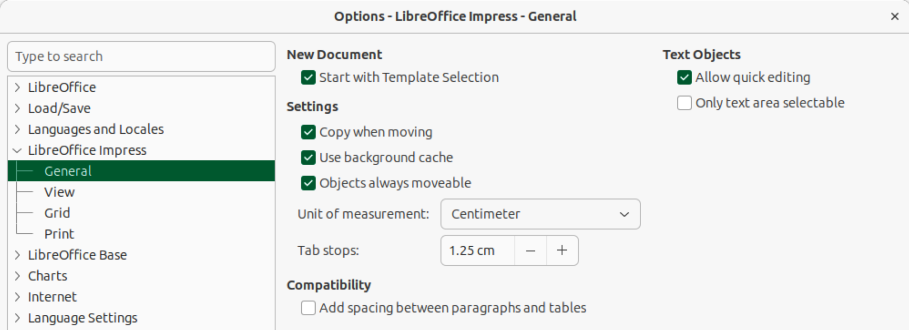
Figure 20: Presentation toolbar

Click on New Slide in the Presentation toolbar (Figure 20). If the Presentation toolbar is not visible, go to View > Toolbars on the Menu bar and select Presentation from the submenu.
Note
A new slide is inserted after the selected slide in the presentation. If a slide is not selected, then the new slide is inserted as the last slide in the presentation.
To duplicate a slide, select a slide for duplication in the Slides pane and use one of the following methods. A duplicate slide is inserted after the selected slide in the presentation.
Right-click on a slide in the Slides pane and select Duplicate Slide from the context menu.
Go to Slide Sorter view in the Workspace, right-click on a slide and select Duplicate Slide from the context menu.
Go to Slide > Duplicate Slide on the Menu bar.
Click on Duplicate Slide on the Presentation toolbar.
Figure 21: Sidebar Properties deck — Slide deck

Click on Properties on the Sidebar to open the Properties deck, then open the Slide panel (Figure 21) to display the format options available for a presentation. The Slide panel allows for quick formatting of all slides included in a presentation and selecting master slides for a presentation. For more information, see Chapter 2, Using Slide Masters, Styles, and Templates and Chapter 8, Adding and Formatting Slides and Notes.
By default in Impress, the Title Slide layout is used for the first slide when a new presentation is created. The layouts included in Impress range from a blank slide to a slide with six contents boxes and a title. For more information on slide layouts, see Chapter 8, Adding and Formatting Slides, and Notes.
The first slide in a presentation is normally a title slide. The layouts Title Slide, which also contains a section for a subtitle, or Title Only are the most suitable layouts for the first slide in a presentation. For the remaining slides, select the most suitable layout to use for slide contents.
Impress does not have the functionality to create custom layouts. However, different elements in a slide layout can be resized and moved, see “Modifying slide elements” on page 1.
The available layouts are shown in the Layouts panel on the Properties deck in the Sidebar. Select a slide, then select the slide layout using one of the following methods:
Go to the Properties deck on the Sidebar to open the Layouts panel (Figure 22).
Click on Slide Layout in the Presentation toolbar and open a pop-up dialog displaying the slide layouts available.
Click on Slide > Layout on the Menu bar to open a submenu displaying the layouts available.
Figure 22: Sidebar Properties deck — Layouts panel
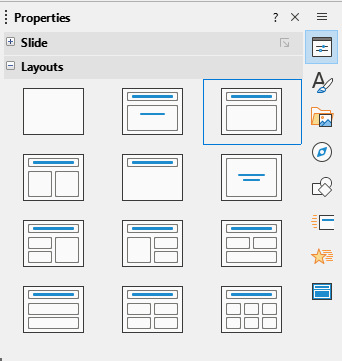
Right-click on the selected slide and select Layouts to open a context menu displaying the layouts available.
Note
The icons that appear in the center of content boxes allow for the insertion of tables, charts, images, audio, or video into a content box, if required.
After selecting a slide in a presentation, change the slide layout using as follows:
1) Select a slide in the presentation.
2) Select a new layout for the slide using one of the methods available in “Selecting slide layouts” on page 1.
Several layouts can contain one or more content boxes, as shown by the example in Figure 23. After selecting a content box, it can be configured to contain the following elements:
Slide title
Text
Table
Chart
Figure 23: Example slide using content boxes

Image
Audio or Video
Note
Text and graphic elements can be adjusted and formatted at any time when creating a presentation. However, changing slide layout that already has contents can have a dramatic effect. If the layout is changed after contents have been added, the contents are not lost, but they may need to be reformatted.
When a slide is inserted into a presentation, it contains elements that were included in the selected slide layout. However, it is unlikely that the predefined layouts suit all requirements for a presentation. Elements required maybe removed or objects inserted, for example, text and/or graphics.
Impress does not have the functionality to create new layouts, but allows for the resizing and moving of the slide elements. It is also possible to add slide elements without being limited to the size and position of content boxes.
Note
It is recommended that changes to slide elements in the layouts included in Impress are only made using Normal view. Attempting any changes to a slide element when in Master Slide view is possible, but may result in unpredictable results and requires extra care as well as a certain amount of trial and error.
1) Click on the outer frame of the contents box so that the selection handles are displayed.
2) Place the cursor on the frame so that the cursor changes shape. This is normally a clenched hand, but depends on the computer setup and operating system.
3) Click and drag the contents box to its new position on the slide, then release.
1) Click on the outer frame so that the selection handles are displayed.
2) Place the cursor on a selection handle the frame so that the cursor changes shape.
3) Click and drag the selection handle on the frame to resize the contents box, then release.
– Top and bottom selection handles change the height of a contents box.
– Left and right selection handles change the width of a contents box.
– Corner selection handles change width and height of a contents box.
1) Click a contents box or an element to highlight it and the selection handles are displayed.
2) Press Delete (macOS Ctrl+D), or Backspace key to remove the contents box or element.
There are two ways of adding text to a slide – contents box or text box. For more information on text, see Chapter 3, Adding and Formatting Text.
Contents box
Text box
To add images or objects to a slide, for example a picture, clipart, drawing, photograph, or spreadsheet, click on Insert on the Menu bar and select in the drop-down menu the image or object type required. For more information on adding objects, see the following chapters:
Chapter 4, Adding and Formatting Images
Chapter 5, Managing Graphic Objects
Chapter 6, Formatting Graphic Objects
Chapter 7, OLE, Spreadsheets, Charts, and Other Objects
To change the background and other characteristics of all slides in a presentation, the master slide has to be modified, or a different master slide selected.
A master slide has a specified set of characteristics that acts as a template and is used as a starting point for creating other slides. These characteristics include slide background, objects in the background, formatting of any text used, and any background graphics.
Impress has a range of master slides, found in the Master Slides deck on the Sidebar. Additional master slides can be created or and saved, or added from other sources. See Chapter 2, Using Slide Masters, Styles, and Templates for information on creating and modifying master slides.
For example, to change the background of an individual slide or a master slide:
1) Right click on a slide or master slide and select Slide Properties from the context menu to open the Slide Properties dialog (Figure 24).
2) Select Background and then select the type of background to use from None, Color, Gradient, Image, Pattern, and Hatch.
3) Make a selection from the various properties available for each type of background.
4) Click OK to apply save the changes and close the dialog.
Note
Inserting and correctly formatting background is beyond the scope of this chapter. For more information, see Chapter 6, Formatting Graphic Objects.
Figure 24: Slide Properties dialog — Background Color page
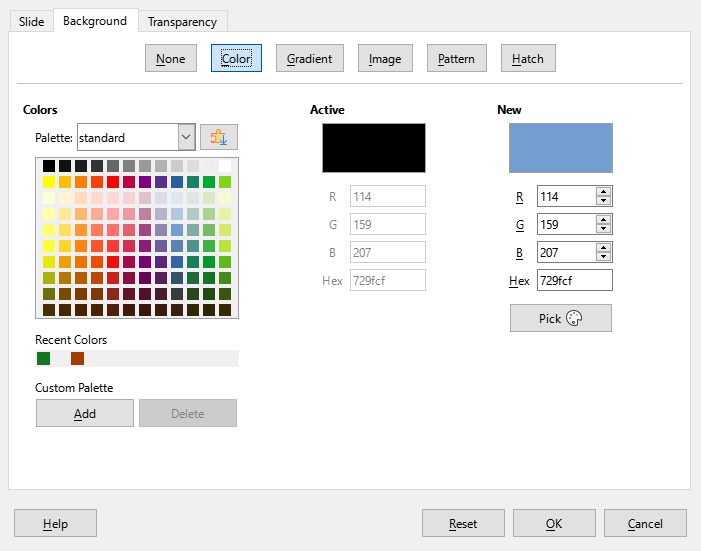
By default, a presentation displays all the slides in the same order as they appear in Slide Sorter view on the Workspace. It is recommended to review the entire presentation before finally creating and saving the presentation. Run the presentation at least once (see “Running a presentation” on page 1), then respond to the following questions. Also, there maybe more questions after running a presentation for the first time.
Are the slides in the correct order? If not, position of some of slides has to be changed.
Is the information well spaced and visible to all members of an audience in a large room?
Would an additional slide make a particular point clearer? If so, create another slide.
Are some of the slides unnecessary? Hide or delete the slides not required.
Would animations help some of the slides? This is considered an advanced technique.
Should some of the slides have a different slide transition than others? The transition of those slides should be changed.
Once the questions have been answered, make the necessary changes. Making changes can be carried out in Slide Sorter view on the Workspace.
Tip
If one or more slides are unnecessary, hide the slide or slides, then view the slide show again to make sure they are not required. To hide a slide, right-click the slide in the Slides pane and select Hide Slide from the context menu. Do not delete a slide until this is done, or the slide may have to be created again.
Change the slide order in a presentation using one of the following methods:
In Slide Sorter view, click on a slide that is being moved and drag it to its new position in the presentation.
In the Slides pane, click on the slide that is being moved and drag it to its new position in the presentation.
If animations are going to be added to slides in a presentation, click on Animation on the Sidebar to open the Animation deck giving access to the various animation options as follows:
Animation category.
Animation effect.
How the animation starts.
Animation direction, duration and delay.
Automatic preview.
Animation is an advanced technique and is beyond the scope of this chapter. For more information on animation, see Chapter 9, Slide Shows & Photo Albums.
To make a presentation more professional, it is recommended to add transitions between each slide in a presentation. Click on Slide Transition on the Sidebar to open the Slide Transition deck giving access to the various transition options as follows:
Transition type.
Modify the transition.
How the slide advances in the presentation.
Automatic preview.
Adding slide transitions is an advanced technique and is beyond the scope of this chapter. For more information on slide transitions, see Chapter 9, Slide Shows & Photo Albums.
When a presentation is completed, it is recommended to run the presentation and make sure that everything is correct before showing the presentation to an audience.
For displaying a presentation to an audience, Impress has a Presenter Console available. However, multiple displays must be connected to the computer for the Presenter Console to function. For more information and details about running a presentation and showing it to an audience, see Chapter 9, Slide Shows & Photo Albums.
1) Start the slide using one of the following methods:
– Go to Slide Show on the Menu bar and select Start from First Slide from the submenu or use the keyboard shortcut F5.
– Go to Slide Show on the Menu bar and select Start from Current Slide from the submenu or use the keyboard shortcut Shift+F5.
2) To display each slide in the presentation during the slide show, use one of the following methods:
– Press the spacebar to advance to the next slide in the presentation.
– Press the arrow keys to show the next or previous slide in the presentation.
– If the option Change slide by clicking on background has been selected in Slide Show Settings, position the cursor on the slide and click to move to the next slide.
3) When the slide show has ended or to exit the slide show before it has finished, press the Esc key to close the slide show and return to Impress.
When multiple displays are connected to a computer, the Presenter Console (Figure 25) becomes available providing extra control over a presentation as follows:
On multiple displays, the audience sees the current slide in the presentation.
The current slide, next slide in the presentation, slide notes, and a presentation timer are displayed on the computer display providing control of how the slide show is presented to the audience.
Starting a slide show using Presenter Console and multiple displays is similar to running a slide show on a single display. For more information and details about using the Presenter Console, see Chapter 9 Slide Shows & Photo Album.
Figure 25: Presenter Console — Current Slide
